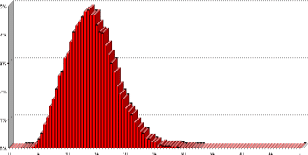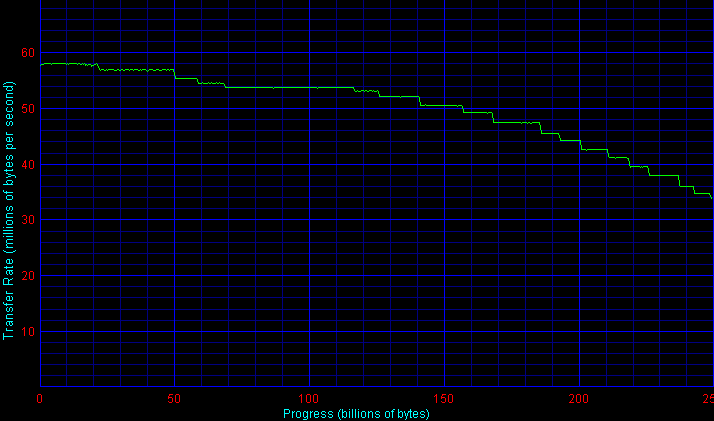|

One such drive is Western Digital’s Caviar WD2500JD. To ease their entry into the SATA market, WD (like Maxtor) has opted to incorporate PATA-to-SATA bridge chips on their latest lineup. The firm’s parallel ATA Caviar WD2500JB has been available for some time now, leading the pack in most 7200 RPM performance measures.
Like the JB, the serial ATA WD2500JD incorporates three 83-gigabyte platters to achieve its roomy 250 GB capacity. WD specs the drive’s seek time at 8.9 milliseconds. A performance-standard 8-megabyte buffer rounds out the offering. As is the case with WD’s JB series, the WD2500JD features a 3-year warranty.
The WD2500JD is actually just one of a few new drives that the manufacturer has or will introduce shortly that may be identified by their suffixes. Interestingly, WD’s PR department has not quite been able to provide an “official” key to what each suffix entry denotes. Unofficially, however, the lineup more or less appears like this:
| WDxxxxBB | – the firm’s basic 7200 RPM drive – 2-megabyte buffers and ball bearing motors |
| WDxxxxJB | – the 7200 RPM, 8-megabyte buffer, ball-bearing models that many have grown to love |
| WDxxxxJD | – a serial ATA version of the JB- 7200 RPM, 8-meg buffer, ball-bearing motors |
| WDxxxxPD | – a version of the JD that everyone wants- will utilize quieter fluid-bearing motors |

Some readers have expressed concern with drives such as the WD2500JD that utilize PATA-SATA bridge chips rather than incorporating a “native” design as, say, Seagate’s drives do. Converters usually exact a performance penalty- the concern is, how much? In the end, such concerns remain irrelevant. Frankly, we are a bit surprised that users would eschew a disk based solely on the inclusion of a bridge. High-level performance should remain the ultimate arbiter. All other things being equal, if a bridged design outperforms another that uses a native setup, it should be the obvious choice- as always, its bottom-line rather than module-level performance that matters.
Low-Level ResultsFor diagnostic purposes only, StorageReview measures the following low-level parameters: Average Read Access Time– An average of 25,000 random accesses of a single sector each conducted through IPEAK SPT’s AnalyzeDisk suite. The high sample size permits a much more accurate reading than most typical benchmarks deliver and provides an excellent figure with which one may contrast the claimed access time (claimed seek time + the drive spindle speed’s average rotational latency) provided by manufacturers. WB99 Disk/Read Transfer Rate – Begin– The sequential transfer rate attained by the outermost zones in the hard disk. The figure typically represents the highest sustained transfer rate a drive delivers. WB99 Disk/Read Transfer Rate – End– The sequential transfer rate attained by the innermost zones in the hard disk. The figure typically represents the lowest sustained transfer rate a drive delivers. |
For more information, please click here.
|
Note: Scores on top are better. |
|
||

|
||
|---|---|---|
The Cavair WD2500JD turns in an average random access time of 14.1 milliseconds. Subtracting 4.2 milliseconds from the score to account for the 7200 RPM rotational latency unveils a measured seek time of 9.9 milliseconds. This score is about 1 ms off of WD’s claim and, interestingly, about 0.3 ms off of the figure turned in by the JD’s parallel twin, the WD2500JB.
|
Note: Scores on top are better. |
|
|||||||||||||||||||||||||||||||||
|
|
||||||||||||||||||||||||||||||||
WD2500JD Transfer Rate
|
|||||||||||||||||||||||||||||||||
As expected, the WD2500JD turns in an outer-zone score of about 58 MB/sec and tapers down to a low of about 36 MB/sec… figures identical to that of the JB.
Single-User PerformanceStorageReview uses the following tests to assess non-server use: StorageReview.com Office DriveMark 2002– A capture of 30 minutes of actual computer productivity use that exactingly recreates a typical office-style multitasking environment. The applications include: Outlook XP, Word XP, Excel XP, PowerPoint XP, Calypso (a freeware e-mail client), SecureCRT v3.3 (a telnet/SSH client), CuteFTP Pro v1.0 (an FTP/SSH client), ICQ 2000b), Palm Hotsync 4.0, Gravity 2.3 (a Usenet/newsgroups client), PaintShop Pro v7.0, Media Player v8 for the occasional MP3, and Internet Explorer 6.0. StorageReview.com High-End DriveMark 2002– A capture of VeriTest’s Content Creation Winstone 2001 suite. Applications include Adobe Photoshop v5.5, Adobe Premiere v5.1, Macromedia Director v8.0, Macromedia Dreamweaver v3.0, Netscape Navigator v4.73, and Sonic Foundry Sound Forge v4.5. Unlike typical productivity applications, high-end audio- and video- editing programs are run in a more serial and less multitasked manner. The High-End DriveMark includes significantly more sequential transfers and write (as opposed to read) operations. |
StorageReview.com Bootup DriveMark 2002– A capture of the rather unusual Windows XP bootup process. Windows XP’s boot procedure involves significantly different access patterns and queue depths than those found in other disk accesses. This test recreates Windows XP’s bootup from the initial bootstrap load all the way to initialization and loading of the following memory-resident utilities: Dimension4 (a time synchronizer), Norton Antivirus 2002 AutoProtect, Palm Hotsync v4.0, and ICQ 2000b.
StorageReview.com Gaming DriveMark 2002– A weighted average of the disk accesses featured in five popular PC games: Lionhead’s Black & White v1.1, Valve’s Half-Life: Counterstrike v1.3, Blizzard’s Diablo 2: Lord of Destruction v1.09b, Maxis’s The Sims: House Party v1.0, and Epic’s Unreal Tournament v4.36. Games, of course, are not multitasked- all five titles were run in a serial fashion featuring approximately half an hour of play time per game.
For more information, please click here.
|
Note: Scores on top are better. |
|
|||||||||||||||||||||||||||||||||
|
|
||||||||||||||||||||||||||||||||
|
|
||||||||||||||||||||||||||||||||
At 417 I/Os per second, the Caviar WD2500JD falls just a bit short of the score turned in by WD’s PATA JB model by a 3% margin. A similar gap carries over to the High-End DriveMark, with the JB again leading the JD by 3%.
It is in the Bootup DriveMark, a test that features higher-than-normal average queue depths, that the SATA drive manages to match the JB’s prowess. Finally, in the SR Gaming DriveMark, a normalized average of drive performance over five popular PC games, the JD again turns in an all-but-identical score, trailing the JB by about 1%.
Multi-User PerformanceStorageReview uses the following tests to assess server performance: StorageReview.com File Server DriveMark 2002– A mix of synthetically-created reads and writes through IOMeter that attempts to model the heavily random access that a dedicated file server experiences. Individual tests are run under loads with 1 I/O, 4 I/Os, 16 I/Os, and 64 I/Os outstanding. The Server DriveMark is a convenient at-a-glance figure derived from the weighted average of results obtained from the four different loads. StorageReview.com Web Server DriveMark 2002– A mix of synthetically-created reads through IOMeter that attempts to model the heavily random access that a dedicated web server experiences. Individual tests are run under loads with 1 I/O, 4 I/Os, 16 I/Os, and 64 I/Os outstanding. The Server DriveMark is a convenient at-a-glance figure derived from the weighted average of results obtained from the four different loads. For more information click here. |
|
Note: Scores on top are better. |
|
|||||||||||||||||||||||||||||||||
|
|
||||||||||||||||||||||||||||||||
ATA drives always perform quite similarly to each other in the Server DriveMarks- that is, they all trail SCSI devices by considerable margins. They are, of course, suitable for light-load use. Perhaps due to its slightly higher random access times, the Caviar WD2500JD turns in scores just a hair behind that that of the JB.
Legacy PerformanceeTesting Lab’s WinBench 99 Disk WinMark tests are benchmarks that attempt to measure desktop performance through a rather dated recording of high-level applications. Despite their age, the Disk WinMarks are somewhat of an industry standard. The following results serve only as a reference; SR does not factor them into final judgments and recommends that readers do the same. |
|
Note: Scores on top are better. |
|
|||||||||||||||||||||||||||||||||
|
|
||||||||||||||||||||||||||||||||
Heat and NoiseIdle Noise– The sound pressure emitted from a drive measured at a distance of 18 millimeters. The close-field measurement allows for increased resolution between drive sound pressures and eliminates interactions from outside environmental noise. Note that while the measurement is an A-weighted decibel score that weighs frequencies in proportion to human ear sensitivity, a low score does not necessarily predict whether or not a drive will exhibit a high-pitch whine that some may find intrusive. Conversely, a high score does not necessarily indicate that the drive exhibits an intrusive noise envelope. Net Drive Temperature– The highest temperature recorded from a 16-point sample of a drive’s top plate after it has been under heavy load for 80 minutes. The figures provided are net temperatures representing the difference between the measured drive temperature and ambient temperature. For more information, please click here. |
|
Note: Scores on top are better. |
|
||||||||||||||||||||||||
|
|
|||||||||||||||||||||||
With a sound pressure level of 46.1 dB/A at a distance of 18 millimeters, the Caviar WD2500JD simply does not deliver the quiet idle noise levels that purchasers have come to enjoy with products such as Seagate’s Barracudas and Maxtor’s latest DiamondMax units. While there is no annoying high-pitch squeal, the WD2500JD may add to the overall noise floor of a quiet system. Seek noises are more typical, par for a 7200 RPM drive. They are just loud enough to assure the user that the drive is executing commands.
A three-platter drive, the WD2500JD creates a fair amount of heat when running in busy conditions. It should integrate well into any system that features adequate ventilation.
ReliabilityThe StorageReview.com Reliability Survey aims to amalgamate individual reader experiences with various hard disks into a comprehensive warehouse of information from which meaningful results may be extracted. A multiple-layer filter sifts through collected data, silently omitting questionable results or results from questionable participants. A proprietary analysis engine then processes the qualified dataset. SR presents results to readers through a percentile ranking system. According to filtered and analyzed data collected from participating StorageReview.com readers, the |
According to filtered and analyzed data collected from participating StorageReview.com readers, a predecessor of the
Western Digital Caviar WD2500JD, the
Western Digital WD2500JB
, is more reliable than of the other drives in the survey that meet a certain minimum floor of participation.
Note that the percentages in bold above may change as more information continues to be collected and analyzed. For more information, to input your experience with these and/or other drives, and to view comprehensive results, please visit the SR Drive Reliability Survey.
ConclusionThe WD2500JD provides the best-of-class solution that WD has become known for in the ATA world. While its bridged design and perhaps some minor controller differences cause it to slip very slightly in some comparisons against the parallel ATA WD2500JB, it nonetheless is a premiere contender for any early-adopter’s SATA system. Though the JD achieves the performance we have come to expect from WD, it also delivers the same (ball-bearing) noise levels. Other manufacturers such as Seagate and Maxtor have made significant strides in incorporating quieter FDB motors across most if not all of their ATA lines; as a result, WD’s drives are weighing in above average in the noise category. The WD2500JD is a nice, fast drive, but with Seagate and Maxtor closing the performance gaps, we are holding our breath for the WD2500PD. |




 Amazon
Amazon